North American Porcupine
- March 15, 2024
- 0 comment
The North American porcupine, scientifically known as Erethizon dorsatum, is a fascinating mammal that inhabits a diverse range of environments across the continent, from the northern regions of Canada to the southern parts of Mexico. Known for its distinctive appearance, the North American porcupine is characterized by its dense coat of sharp quills, which serve as a formidable defense mechanism against predators. These quills, when threatened, can be raised to deter potential threats or even detached and embedded into the attacker, causing discomfort or injury.
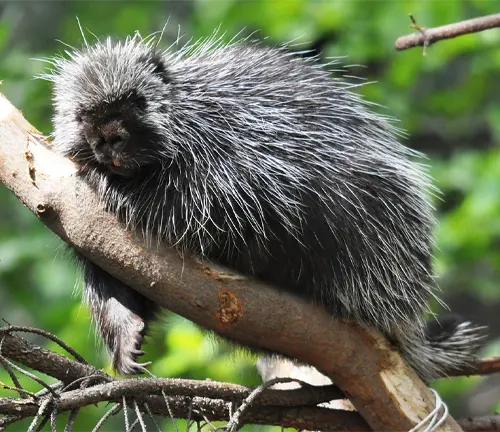
Despite their intimidating appearance, porcupines are primarily herbivores, feeding on a diet consisting mainly of bark, twigs, and leaves. They are solitary creatures, preferring to avoid social interactions except during the breeding season. While conflicts with humans may arise due to their tendency to gnaw on trees, causing damage to crops or property, porcupines generally play a vital role in their ecosystems as seed dispersers and herbivores. Despite facing threats such as habitat loss and human encroachment, conservation efforts aim to protect these iconic animals and ensure their continued presence in the wild.
| Specification | Description |
|---|---|
| Scientific Name | Erethizon dorsatum |
| Size | Up to 36 inches in length |
| Weight | Between 12 to 35 pounds |
| Coat | Dense with sharp quills covering most of the body |
| Habitat | Diverse environments from Canada to Mexico |
| Diet | Mainly herbivorous, feeding on bark, twigs, and leaves |
| Behavior | Nocturnal and solitary |
| Defense Mechanism | Raises quills when threatened, can detach and embed quills into attackers |
| Range | Across North America |
| Social Behavior | Solitary, except during breeding season |
| Reproduction | Gives birth to a single offspring after a gestation period of around seven months |
| Conservation Status | Not currently considered endangered, but faces threats from habitat loss and human activities |
The Fascinating World of the North American Porcupine
Porcupines are fascinating creatures known for their unique appearance and defense mechanisms. Among the various species of porcupines worldwide, the North American porcupine (Erethizon dorsatum) stands out for its distinctive traits and behaviors.
Physical Characteristics
Here are the physical characteristics of the North American porcupine:
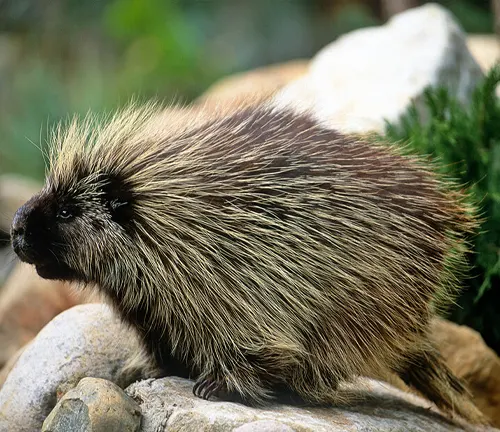
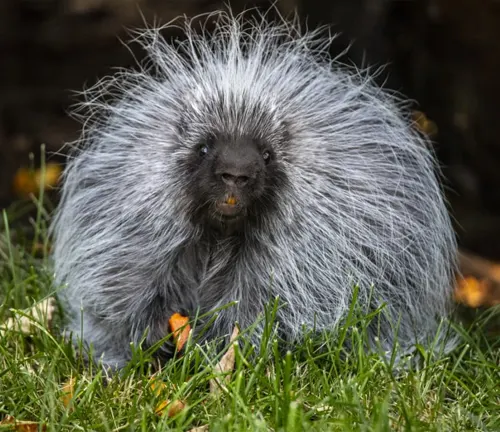
- Size: The North American porcupine is a large rodent, typically measuring up to 36 inches (90 cm) in length from head to tail.
- Weight: Adults can weigh anywhere between 12 to 35 pounds (5.4 to 16 kg), with males typically being larger than females.
- Coat: One of the most distinctive features of the North American porcupine is its dense coat of quills. These quills are actually modified hairs that cover most of the animal’s body, giving it a spiky appearance.
- Coloration: The color of the porcupine’s coat can vary depending on its habitat, but it is typically a mixture of brown, black, and white. Some individuals may have lighter or darker variations of these colors.
- Quills: Porcupines have thousands of sharp, barbed quills covering their bodies. These quills serve as a primary defense mechanism against predators. When threatened, the porcupine raises its quills to make itself appear larger and more intimidating.
- Tail: Porcupines have a relatively short, thick tail that is covered in quills. This tail is prehensile, meaning it can grasp objects, aiding in climbing and balance.
- Feet: The North American porcupine has four short legs with sharp claws that help it climb trees and navigate its environment.
- Face: The face of the porcupine is characterized by a small, rounded head with large eyes and ears. Its snout is blunt, and it has strong jaw muscles for gnawing on vegetation.
Habitat and Distribution
Here’s information about the habitat and distribution of the North American porcupine:
Habitat
The North American porcupine is a highly adaptable species that can be found in a wide range of habitats across North America. They are commonly found in forests, woodlands, grasslands, and mountainous regions. Porcupines are also known to inhabit desert areas, provided there is enough vegetation for them to feed on. They are often found near water sources such as rivers, streams, and lakes. Porcupines are adept climbers and are commonly seen in trees, although they also spend time on the ground foraging for food.
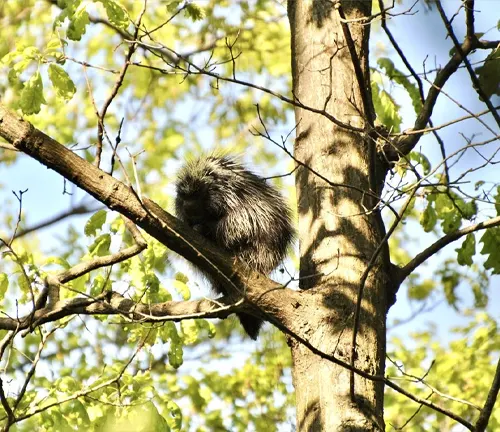

Distribution
The North American porcupine has a broad distribution range, spanning from northern Canada to parts of Mexico. They are found throughout the contiguous United States and into southern Canada, with populations also present in Alaska. Porcupines are most abundant in regions with dense forests and ample vegetation, but they can also be found in more open habitats such as grasslands and shrublands. While they are not typically found in urban areas, porcupines may occasionally venture into suburban or agricultural landscapes in search of food and shelter.
Behavior and Lifestyle
Behavior
The North American porcupine is primarily nocturnal, meaning it is most active during the night. During the day, porcupines typically rest in dens or hollow trees, avoiding the heat and potential predators. They are solitary animals and are usually seen alone, although they may occasionally come together during the breeding season.
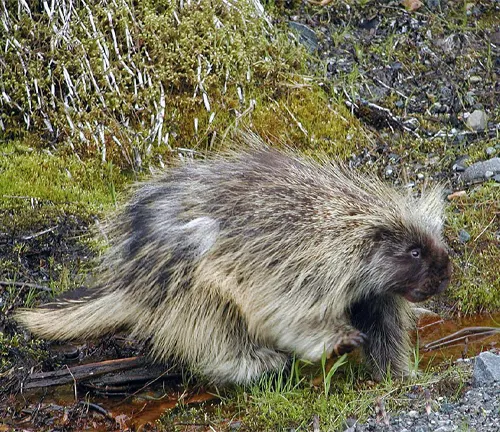
Porcupines are generally docile creatures and prefer to avoid confrontation with other animals. When threatened, they rely on their primary defense mechanism: their sharp quills. Porcupines will raise their quills to make themselves appear larger and more intimidating. If approached further, they may lash out with their tail or rear up on their hind legs to strike potential threats with their quills. Contrary to popular belief, porcupines cannot shoot their quills but will instead rely on physical contact to transfer their spines to predators.
Lifestyle
As herbivores, porcupines have a specialized diet consisting mainly of bark, twigs, leaves, and other plant materials. They use their strong jaws and sharp incisors to gnaw on trees and branches, often leaving behind distinctive tooth marks on vegetation. Porcupines are known to be selective feeders, preferring certain types of trees and plants over others.
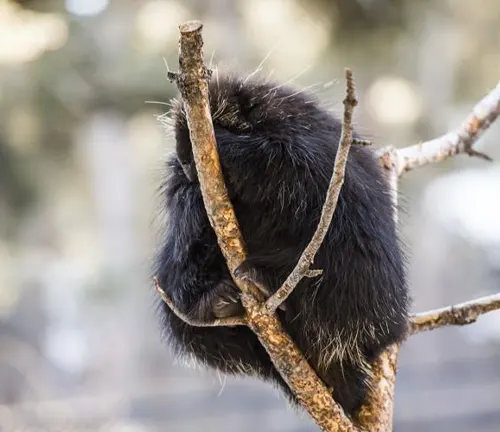
Despite being solitary animals, porcupines may occasionally come together during the breeding season, which typically occurs in late summer to early fall. Male porcupines will engage in elaborate courtship displays to attract females, often emitting vocalizations and engaging in scent-marking behavior. After mating, females will give birth to a single offspring, known as a porcupette, after a gestation period of around seven months.
Reproduction and Life Cycle
Here’s information about the reproduction and life cycle of the North American porcupine:
Reproduction
The North American porcupine typically reproduces once a year, with the breeding season occurring in late summer to early fall. During this time, male porcupines actively seek out females for mating. Male porcupines may engage in elaborate courtship rituals to attract females, including vocalizations, scent-marking, and chasing behavior.
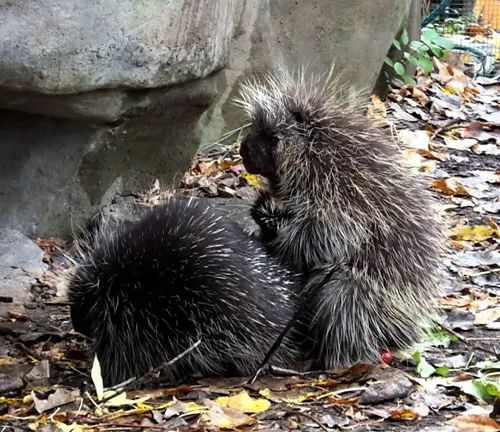
Once a male successfully mates with a female, the female becomes pregnant and will carry the developing offspring, known as a porcupette, for a gestation period of approximately seven months. Porcupines are considered to have a relatively long gestation period compared to other rodents.
Life Cycle
After the gestation period, the female gives birth to a single porcupette, although twins may rarely occur in some cases. Porcupettes are born with soft quills that harden and become sharper within a few hours after birth. Despite their prickly appearance, porcupettes are born relatively defenseless and rely on their mother for protection and nourishment.

The mother porcupine takes on the primary responsibility of caring for the porcupette, nursing it and providing warmth and protection in the den. Porcupettes typically stay with their mother for several months, gradually learning essential survival skills such as foraging and climbing.
As the porcupette grows and becomes more independent, it eventually leaves the den to explore its surroundings and establish its territory. Porcupines reach sexual maturity at around two years of age, at which point they become capable of reproducing and continuing the life cycle.
Interactions with Humans
Conflicts with Humans
While North American porcupines typically prefer to avoid humans and will retreat when encountered, conflicts between porcupines and humans can arise in certain situations. One common source of conflict is when porcupines damage property or crops by gnawing on trees, wooden structures, or garden plants. In rural and suburban areas, porcupines may also cause damage to vehicles by chewing on brake lines and other rubber components.

Cultural Significance
Despite occasional conflicts, porcupines hold cultural significance in various indigenous traditions and folklore across North America. In some Native American cultures, the porcupine is considered a symbol of protection and wisdom. Porcupine quills have been used for decorative purposes in traditional crafts such as quillwork, where they are dyed and woven into intricate patterns on clothing, baskets, and other items.
Conservation Efforts
In recent years, there has been growing awareness of the importance of conserving North American porcupine populations and their habitats. Conservation efforts focus on minimizing human-wildlife conflicts through strategies such as habitat preservation, wildlife corridors, and public education initiatives. These efforts aim to promote coexistence between humans and porcupines while ensuring the long-term survival of these unique animals in the wild.
Myths and Misconceptions
Folklore and Misconceptions
Porcupines have been the subject of many myths and misconceptions throughout history, often leading to misunderstandings about their behavior and capabilities. One common misconception is the belief that porcupines can “shoot” their quills at predators. In reality, porcupines cannot actively propel their quills but will instead rely on physical contact to transfer their spines to potential threats.
Dispelling Common Myths
Dispelling myths and misconceptions about porcupines is essential for promoting accurate understanding and coexistence with these fascinating animals. By educating the public about porcupine behavior and biology, we can help prevent unnecessary fear or harm towards these creatures. Additionally, raising awareness about the natural behaviors and ecological importance of porcupines can foster appreciation and respect for their role in the ecosystem.
Threats and Conservation Status
Threats
North American porcupines face various threats to their populations and habitats, including:
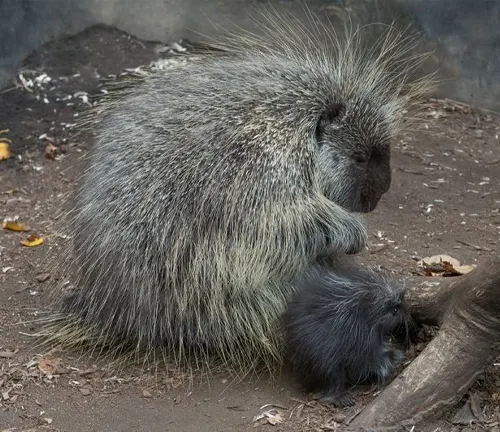
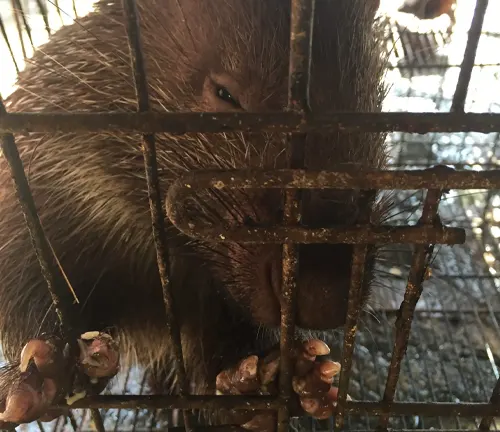
- Habitat Loss: As human populations expand and development encroaches on natural habitats, porcupines may lose crucial feeding and nesting areas.
- Vehicle Collisions: Porcupines are sometimes struck by vehicles while crossing roads, particularly in areas where human development intersects with their habitat.
- Illegal Hunting: While porcupines are not typically targeted by hunters for their meat or fur, they may be killed illegally by individuals who view them as pests or nuisances.
Conservation Status
The North American porcupine is currently classified as a species of least concern by the International Union for Conservation of Nature (IUCN). Despite facing threats from habitat loss, vehicle collisions, and human activities, porcupine populations remain relatively stable across their range.
Conservation Efforts
Conservation efforts for North American porcupines focus on protecting their habitats and mitigating human-wildlife conflicts. Strategies include:
- Habitat Preservation: Establishing protected areas and wildlife corridors to conserve porcupine habitats and ensure connectivity between populations.
- Public Education: Raising awareness about the ecological importance of porcupines and promoting coexistence through outreach programs and educational initiatives.
- Wildlife Management: Implementing measures to reduce conflicts between porcupines and humans, such as installing barriers to protect crops and property.
Importance in Ecosystem
Ecological Role
North American porcupines play a crucial role in their ecosystems as herbivores and seed dispersers. Their feeding habits and behaviors contribute to the health and diversity of plant communities, which in turn, support a wide range of other wildlife species.
Vegetation Control
Porcupines primarily feed on bark, twigs, leaves, and other plant materials. By selectively foraging on certain plant species, porcupines can help control vegetation growth and prevent the dominance of particular plant species in their habitats. This grazing behavior promotes plant diversity and maintains balanced ecosystems.
Seed Dispersal
As they consume vegetation, porcupines inadvertently ingest seeds from various plant species. These seeds can remain viable in the porcupine’s digestive tract and are dispersed over a wide area through their feces. This process helps plants colonize new areas, enhances genetic diversity, and contributes to the regeneration of forests and other ecosystems.
Habitat Modification
Porcupines also play a role in habitat modification through their feeding and nesting behaviors. By gnawing on trees and creating dens in hollow logs or burrows, porcupines create habitat structures that benefit a variety of other wildlife species, including birds, insects, and small mammals.
Research and Study
Scientific Research
Scientific research on North American porcupines plays a crucial role in understanding their behavior, ecology, and conservation needs. Researchers study various aspects of porcupine biology, including:
- Behavior: Investigating porcupine behavior, such as foraging patterns, mating rituals, and social interactions, helps scientists understand how porcupines interact with their environment and other species.
- Ecology: Studying the ecological role of porcupines in their ecosystems, including their effects on vegetation dynamics, seed dispersal, and habitat modification, provides insights into ecosystem dynamics and functioning.
- Physiology: Research into porcupine physiology, including digestive processes, reproductive biology, and immune system function, helps scientists understand how porcupines adapt to their environment and respond to environmental changes.
- Conservation: Research on porcupine populations, distribution, and threats informs conservation efforts aimed at protecting porcupine habitats and populations.
Contribution to Understanding Ecosystems
Research on North American porcupines contributes to our broader understanding of ecosystems and biodiversity conservation. By studying porcupine ecology and behavior, scientists gain insights into the complex interactions between species and their environments, helping to inform management and conservation strategies for entire ecosystems.
Unique Adaptations
Evolutionary Adaptations
The North American porcupine has evolved several unique adaptations that enable it to survive and thrive in diverse habitats across its range. These adaptations include:
- Quill Defense Mechanism: One of the most distinctive adaptations of the porcupine is its quill defense mechanism. Porcupines have thousands of sharp, barbed quills covering their bodies, which they can raise when threatened to make themselves appear larger and more intimidating. These quills serve as a formidable deterrent against predators, providing the porcupine with protection from potential threats.
- Nocturnal Behavior: Porcupines are primarily nocturnal animals, meaning they are most active during the night. This nocturnal behavior helps porcupines avoid predators and reduce the risk of encountering potential threats while foraging for food.
- Specialized Diet: Porcupines have a specialized diet consisting mainly of bark, twigs, leaves, and other plant materials. Their strong jaws and sharp incisors enable them to gnaw on tough vegetation, allowing them to extract nutrients from otherwise inaccessible food sources.
- Climbing Abilities: Porcupines are adept climbers and are capable of scaling trees with ease using their sharp claws and prehensile tails. This climbing ability allows porcupines to access food and escape from predators by retreating to the safety of treetops.
Survival Strategies
These unique adaptations of the North American porcupine illustrate its remarkable resilience and ability to thrive in various environments. By relying on its quill defense mechanism, nocturnal behavior, specialized diet, and climbing abilities, the porcupine has evolved effective strategies for survival in the face of adversity.
Fascinating Facts
- Quill Composition: Porcupine quills are made of keratin, the same material found in human hair and fingernails. Despite their sharp appearance, porcupine quills are lightweight and hollow, allowing them to be easily embedded into predators or potential threats.
- Nocturnal Lifestyle: North American porcupines are primarily nocturnal, meaning they are most active during the night. This behavior helps them avoid predators and reduces the risk of encountering potential threats while foraging for food.
- Old World vs. New World Porcupines: While Old World porcupines (found in Africa, Europe, and Asia) are known for their large size and predominantly terrestrial lifestyle, New World porcupines (such as the North American porcupine) are smaller and more arboreal, spending much of their time in trees.
- Tree Climbing Abilities: Despite their bulky appearance, porcupines are skilled climbers and are capable of scaling trees with ease using their sharp claws and prehensile tails. They often retreat to the safety of treetops to escape predators or seek refuge.
- Longevity: In the wild, North American porcupines have an average lifespan of around 5 to 7 years. However, porcupines kept in captivity have been known to live much longer, with some individuals reaching ages of up to 10 or even 15 years.
- Diverse Vocalizations: While porcupines are not known for being particularly vocal, they do produce a variety of sounds to communicate with each other. These vocalizations include grunts, whines, and even a distinctive teeth-chattering noise.
- Antibacterial Properties: The barbed quills of the porcupine are not only effective for defense but also possess antibacterial properties. This feature helps prevent infections when the quills penetrate the skin of potential predators or threats.
- Selective Feeding Habits: Porcupines are selective feeders and often have preferences for certain types of trees and vegetation. They may target trees with soft bark or easily accessible leaves, leaving behind distinctive tooth marks on the chewed surfaces.
- Slow Reproduction Rate: North American porcupines have a relatively slow reproductive rate compared to other rodents. Females typically give birth to a single offspring, known as a porcupette, after a gestation period of around seven months.
- Adaptability: Despite facing threats from habitat loss and human activities, North American porcupines are highly adaptable creatures and can be found in a wide range of habitats across their range, from dense forests to open grasslands.
Different Species
The North American porcupine (Erethizon dorsatum) is the only species of porcupine found in North America. While there are various subspecies of the North American porcupine, they all belong to the same species.
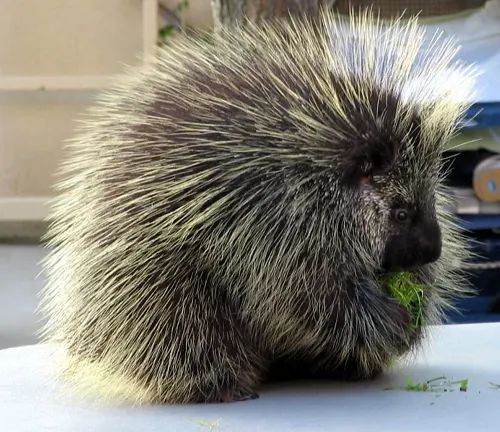
Frequently Asked Question (FAQs)
- What do porcupines eat?
Porcupines are herbivores and primarily feed on bark, twigs, leaves, and other plant materials. - How do porcupines defend themselves?
Porcupines defend themselves by raising their quills when threatened. If approached further, they may lash out with their sharp spines, potentially embedding them into the attacker. - Are porcupines dangerous to humans?
Porcupines are not typically aggressive towards humans, but they can cause harm if approached or handled improperly due to their sharp quills. - Do porcupines shoot their quills?
Contrary to popular belief, porcupines cannot shoot their quills at predators. Instead, they rely on physical contact to transfer their spines. - Are porcupines endangered?
North American porcupines are not currently considered endangered, but they face threats from habitat loss, vehicle collisions, and illegal hunting in some regions. - Where do porcupines live?
Porcupines inhabit a wide range of environments across North America, including forests, grasslands, and mountainous regions. - How long do porcupines live?
Porcupines have an average lifespan of around 5 to 7 years in the wild, although some individuals may live longer in captivity. - Do porcupines have any predators?
While porcupines have few natural predators due to their formidable quills, they may still fall prey to large predators such as mountain lions, bobcats, and fishers. - Can porcupines climb trees? Yes, porcupines are excellent climbers and are capable of scaling trees with ease using their sharp claws and prehensile tails.
- Do porcupines hibernate?
Porcupines do not hibernate but may become less active during the winter months, especially in colder regions. They rely on their thick coats and fat reserves to survive the winter.




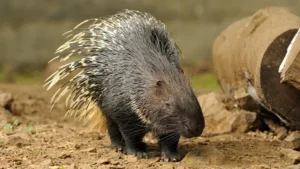



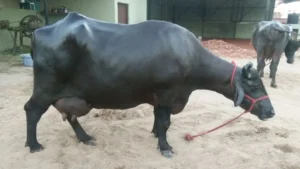

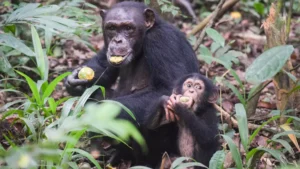
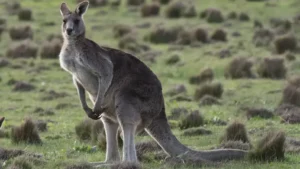
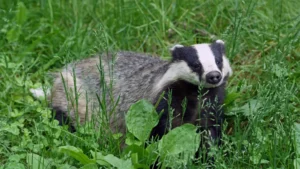
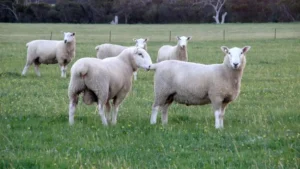
Leave your comment